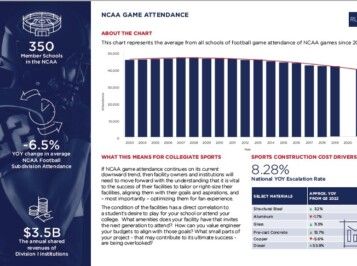Offering clients the level of certainty they need to make critical, real-time decisions to ensure the commercial success of their sports projects.
Our collegiate sports outlook document lets industry leaders and clients know what factors to keep an eye on, whether that be labor and materials, the state of the market, or industry trends. We also keep you informed on sport construction cost drivers and what information like this means for the future of the sector.
Things to watch out for
Labor & Materials
With the construction unemployment rate at 3.4% many contractors are struggling to find enough workers in a market where demand for construction outpaces the availability of the workforce. In one of the most challenging work environments, sports construction demands experienced skilled labor, and finding the right team is vital to project success. Finding that right team requires an understanding of your local market, including knowing how ‘hot’ or slow the local construction market is and thoroughly vetting your contractor and subcontractor pools.
Lead times continue to be a moving target, particularly for site selection and those trades that are driving collegiate sport facility schedules and costs (pre-cast concrete, major mechanical and electrical equipment, structural steel) and thought needs to be given to alternative procurement approaches such as bulk-buying, pre-purchasing and early-release packages.
State of the Market
The latest Architectural Billings Index is 53.3, having bounced back from a three-month decline. A score above 50 still indicates moderately strong conditions overall. The ABC Construction Backlog Indicator showed a slight decline following its peak in May 2022. There is waning confidence in the industry amid fears of a recession and rising borrowing costs, which may lead to a slowing of construction activity generally. This could mean further improvement in supply chain bottlenecks and an easing of commodity prices and materials escalation. While we expect inflation rates to level off from their all-time highs, we anticipate a slow process. With the current state of collegiate sports and many universities choosing to realign their conferences, current facilities may not align or compare with their new competition.
Trending
With declining attendance it may be time to think about right-sizing facilities, creating flexible multipurpose venues, and incorporating new-age amenities to maximize the fan and student athlete experience alike. Often, collegiate sports facilities are competing for the spotlight as they see conflicting interests in terms of need, want, cost, schedule, and return on investment. Stakeholder management is key: those who may not want to pay for it, advocates who may not be able to afford it, and public perception – among others. Strategies need to be priced and analyzed in detail to provide a full lifecycle picture to inform decision making.
Smaller, more flexible sports facilities are becoming a trend, as they lend themselves well to multipurpose use, allowing the owner or institution to maximize the potential of their investment, and enhance public perception as a greater benefit to the community.
About the chart
This chart represents the average from all schools of football game attendance of NCAA games since 2003.

What this means for collegiate sports
If NCAA game attendance continues on its current downward trend, then facility owners and institutions will need to move forward with the understanding that it is vital to the success of their facilities to tailor or right-size their facilities, aligning them with their goals and aspirations, and – most importantly – optimizing them for fan experience.
The condition of the facilities has a direct correlation to a student’s desire to play for your school or attend your college. What amenities does your facility have that invites the next generation to attend? How can you value engineer your budgets to align with those goals? What small parts of your project – that may contribute to its ultimate success – are being overlooked?
FURTHER INFORMATION:



